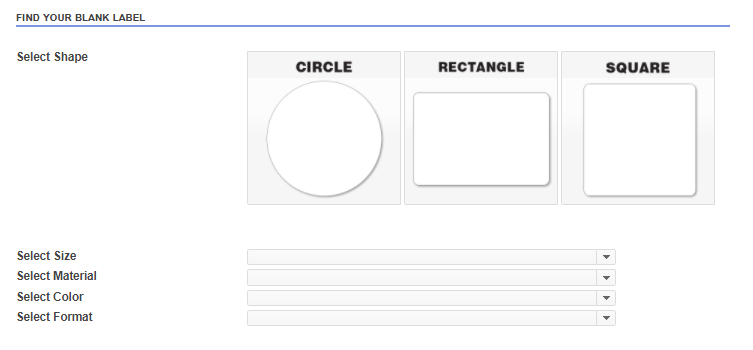Understanding How Blank Labels Job to Boost Your Labeling Experience
Understanding the auto mechanics of blank labels is necessary for optimizing your labeling practices throughout different contexts. These flexible tools use substantial benefits, such as modification and flexibility, making them a suitable choice for both professional setups and personal usage. From supply monitoring to home organization, the ramifications of their tactical application can result in enhanced performance. To fully comprehend how these labels can transform your procedures, one must think about the various kinds available and the myriad ways they can be customized to suit specific requirements.

Advantages of Making Use Of Blank Labels
Blank labels use a functional solution for different identifying demands, making them very useful in both personal and specialist setups. Their adaptability enables customers to create personalized labels customized to details requirements, improving organizational performance. Whether made use of in office, retail atmospheres, or commercial applications, blank labels assist in the identification and categorization of products, documents, and personal items.
One significant advantage of blank labels is their cost-effectiveness. By permitting individuals to publish just the labels they require, waste is minimized, and stock monitoring comes to be more workable. Furthermore, blank labels are compatible with various printing techniques, consisting of inkjet and printer, making them easily accessible for various customers.

Moreover, using blank labels streamlines the process of upgrading details, as individuals can conveniently publish new labels to change obsolete ones, guaranteeing that all products and files are properly classified. Generally, blank labels offer a functional and efficient labeling solution for varied applications.
Types of Blank Labels Available
What options are available when it comes to blank labels? Blank labels come in a selection of kinds, each suited for different applications and choices.
An additional preferred alternative is synthetic labels, frequently made from materials like polyester or vinyl. These labels are recognized for their resilience and resistance to water, chemicals, and tearing, making them ideal for extreme settings. They are frequently utilized in commercial setups or for labeling products that may be exposed to moisture.
In addition, there are thermal transfer labels, which require a printer that makes use of warmth to transfer ink onto the tag surface. These labels are preferred for their high-grade print and durability.
Last but not least, specialty labels provide to particular needs, such as detachable labels for short-lived usage or high-temperature labels for extreme problems. Recognizing these options allows individuals to choose the most proper blank tag for their special labeling demands.
Personalization Options for Labels
A vast selection of customization choices is available for labels, permitting individuals to tailor them to particular demands and branding needs. Individuals can pick from different sizes, shapes, and products to guarantee that the labels effectively fit their desired function. Common products consist of paper, polyester, and vinyl, each providing different degrees of longevity and visual appeal.
Color options play a vital duty in personalization, making it possible for brands to keep consistency with their business identity. Customers can pick from a range of colors or even choose personalized printing to match certain branding components. Furthermore, labels can be printed with unique designs, logos, and text, improving brand name recognition and aesthetic influence.
An additional essential aspect is the selection of adhesive. Tags can be developed with long-term, removable, or repositionable adhesives, depending on the application requirements. This flexibility permits efficient labeling options across various atmospheres, from retail to industrial settings.

Tips for Effective Labeling
Efficient labeling goes past modification; it also entails strategic considerations that enhance functionality and interaction. To attain effective labeling, start by plainly defining the function of each label.
Following, prioritize exposure by choosing appropriate colors and font styles. High comparison in between message and background enhances readability, while larger typefaces promote fast identification. Furthermore, make sure that labels are placed in a constant and sensible manner, making it easier for users to locate and translate details.
Take into consideration the longevity of labels too. Pick products fit for the certain setting where the labels will be made use of, whether it be indoors or outdoors. Waterproof or tear-resistant options might be necessary relying on the context.
Last but not least, routinely testimonial and upgrade your labels to show any kind of changes in info or use. This positive strategy not only maintains clarity however also avoids complication over time. By adhering view it to these pointers, you can optimize the effectiveness of your labeling efforts, guaranteeing they serve their intended objective successfully.
Applications of Blank Labels
Blank labels offer numerous applications throughout various markets, making them a very useful device for company and interaction. These versatile labels are typically used in stockrooms for inventory administration, enabling businesses to easily recognize and track items. By applying blank labels to storage containers, shelves, or pallets, business can streamline their procedures and decrease the possibility of errors.
In the medical care sector, blank labels play an important function in classifying medications and medical supplies, ensuring proper recognition and usage. Customizable labels can consist of essential info such as dosage, expiration days, and individual information, anonymous enhancing safety and compliance.
In retail, blank labels aid in pricing items, offering promos, or labeling rack places, which inevitably boosts the client experience. They permit fast updates to pricing or product details without the need for pre-printed labels.
In addition, blank labels are helpful for individual usage, such as organizing office, crafting, or identifying food containers. Their versatility permits people to create tailored remedies that satisfy certain needs. In general, the applications of blank labels are considerable, underscoring their value in fostering effectiveness and clearness in numerous setups.
Conclusion
Finally, blank labels offer a flexible helpful resources and effective option for various identifying requirements. Their adaptability in size, shape, and product allows for tailored applications across various atmospheres. By leveraging modification alternatives and efficient labeling techniques, organizations can improve quality and interaction (Blank Labels). Ultimately, the integration of blank labels right into operational processes contributes to boosted performance, making them an indispensable resource for both personal and expert use.